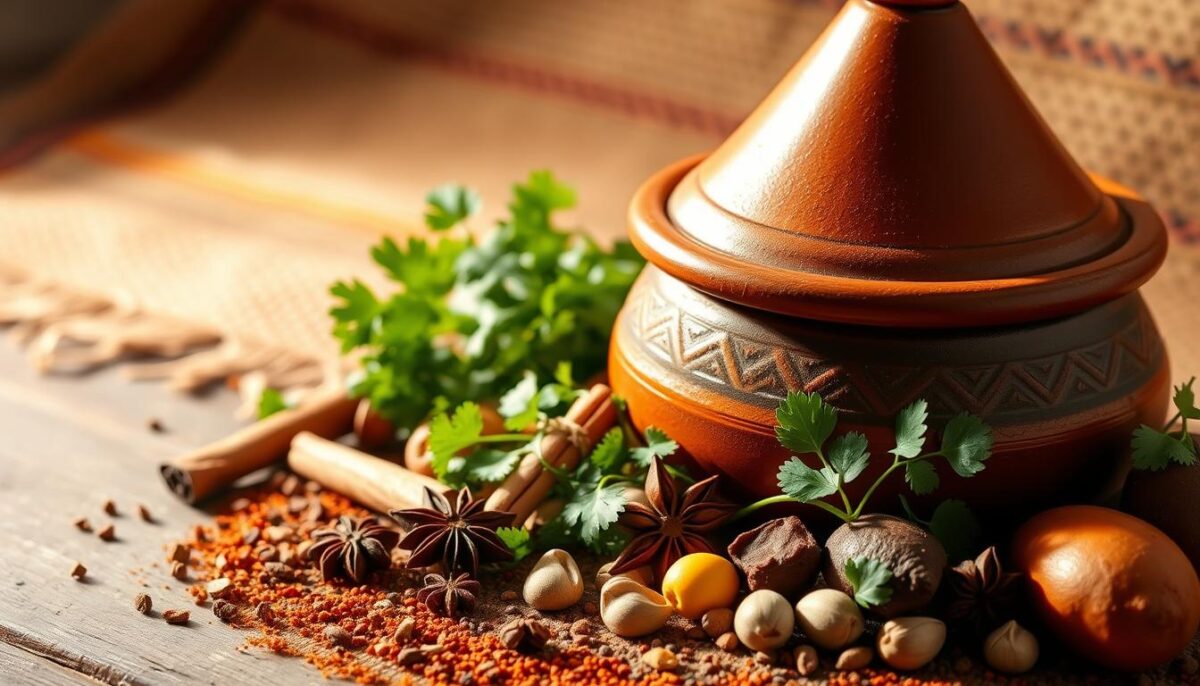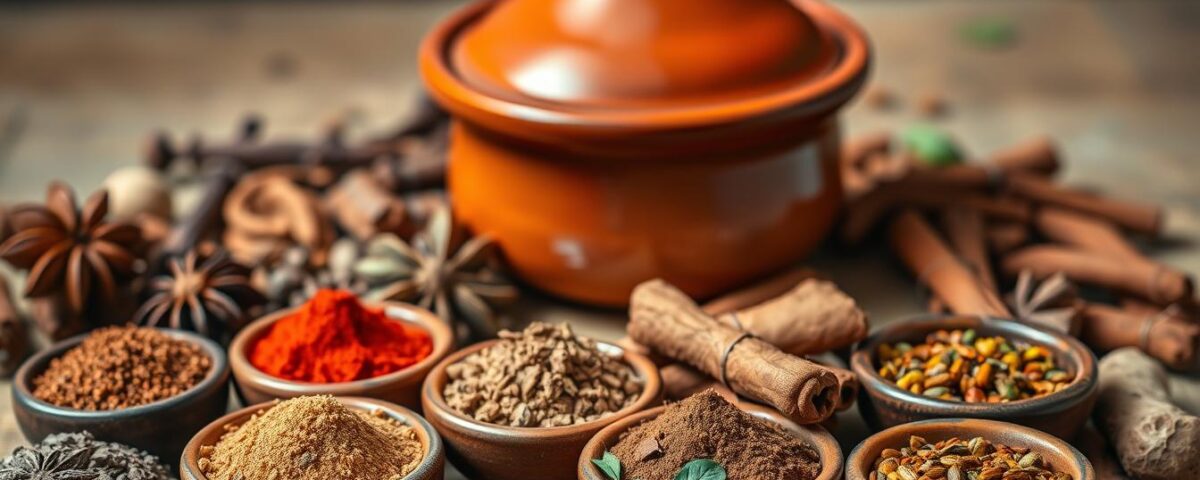
How to Cook Brazil’s Famous Feijoada Black Bean Stew
May 7, 2025
How to Ferment Korean Kimchi with Authentic Home Methods
May 7, 2025Did you know that 78% of home cooks who try to recreate global dishes at home say North African flavors are the hardest to get right? I learned this the hard way—until I discovered how a single spice blend could unlock an entire culinary tradition. Let me show you how to turn that struggle into a triumph.
When I first tasted a properly seasoned tagine, it felt like stepping into a Marrakech market. The warmth of cinnamon, the earthy kick of cumin, and the gentle heat of paprika danced together in a way that store-bought mixes never achieved. That moment inspired me to master the art of balancing these vibrant flavors—and today, I’m sharing everything I’ve learned.
You don’t need fancy equipment or rare ingredients. In fact, my method uses common spices you likely already own. The secret lies in toasting whole seeds to intensify their aroma, then blending them with care. This approach creates depth that elevates everything from lamb stews to roasted vegetables. (Want to pair it with perfectly sautéed meat? I’ve got you covered.)
What makes this blend special isn’t just the taste—it’s the centuries of history in every pinch. These spices traveled ancient trade routes, transforming humble ingredients into celebratory feasts. Now, they can do the same in your kitchen.
Key Takeaways
- A balanced spice mix transforms simple ingredients into complex, restaurant-quality dishes
- Toasting whole spices unlocks deeper flavors than pre-ground versions
- Traditional North African cooking adapts easily to modern American kitchens
- Historical spice combinations tell stories through every bite
- Versatile blends work in stews, roasts, and even vegetarian meals
Exploring the Rich History of North African Spices
Imagine holding a clay pot that’s simmered meals for centuries. That’s exactly what hit me when I first gripped the handle of a traditional conical cooking vessel. Its design isn’t just aesthetic—the shape traps steam, circulating flavors in a way modern pots can’t replicate.
The Story Behind Tagine Cooking
Families here have perfected slow-cooked dishes over generations. I learned from a chef in Fez how the pot’s unique airflow system tenderizes even the toughest cuts. “Our ancestors cooked with what the land provided,” she told me, stirring a lamb stew that smelled like smoky apricots.
Key Spices and Their Cultural Significance
Black pepper once traded weight-for-weight with gold along ancient routes. Turmeric’s golden hue symbolized prosperity in wedding feasts. During my first market visit, a vendor handed me a pinch of paprika-stained blend, whispering, “This mix won wars.”
Regional differences shape these flavors:
- Coastal areas lean on briny preserved lemons
- Mountain villages use wild herbs like za’atar
- Urban centers blend sweet and savory with dried fruits
These traditions transformed my approach. Now, I measure spices by scent memory—not teaspoons.
Crafting the Ideal Moroccan Tagine Spice Recipe
My kitchen smelled like a sunbaked market stall the day I cracked the code to vibrant flavor layering. The secret? Treating each component like precious cargo—from sourcing to stirring.

Sourcing Authentic Ingredients
I hunt for whole spices at international markets or specialty stores. Look for:
- Plump cumin seeds with earthy aromas
- Bright golden turmeric powder that stains your fingers
- Knobby ginger root with taut skin
A vendor once told me, “Freshness isn’t a luxury—it’s the foundation.” I never compromise on quality.
Step-by-Step Mixing Process
Here’s my go-to ratio for balanced heat and sweetness:
- Toast 2 tbsp cumin seeds until fragrant
- Combine with 1 tsp sea salt + ¾ tsp cinnamon
- Add 1 tsp each: ground ginger + turmeric
- Mix in ½ tsp black pepper
Pro tip: Grind everything together for 10 seconds in a blender. Taste and adjust—sometimes I add a pinch of clove for depth.
Tips on Storage and Shelf Life
Keep flavors vibrant by:
- Using glass jars with tight seals
- Storing away from light/heat
- Labeling with the blend date
Your mix will stay potent for 4-6 weeks. For longer storage, freeze portions in ice cube trays. Trust me—it beats bland, dusty spices any day.
Exploring Versatile Uses and Tagine Cooking Techniques
Ever wondered how a single blend could reinvent your weekly menu? I discovered its power when my roasted carrots unexpectedly became the star of a dinner party. This mix isn’t confined to stews—it’s your ticket to bold flavors in everyday cooking.
Adapting the Blend for Hearty Dishes
Slow-cooked meals shine with this combination. Try these adjustments:
| Dish Type | Spice Quantity | Cooking Method |
|---|---|---|
| Vegetable Stews | 1.5 tsp per lb | Simmer 45+ mins |
| Lentil Soups | 2 tsp per pot | Low heat 30 mins |
| Braised Meats | 1 tbsp rub | Oven 275°F |
My Tagine-Spiced Carrot Soup became a hit by adding an extra crack of pepper during blending. The heat builds gradually—perfect for chilly evenings.
Everyday Flavor Boosts
Sprinkle this mix where you’d normally use plain salt. Last week, I tossed roasted chickpeas with ½ tsp blend + olive oil. My kids devoured them like candy.
Three unexpected favorites:
- Stirred into hummus (start with ¼ tsp)
- Mixed with yogurt for grilled chicken marinade
- Shaken over popcorn with melted butter
Remember: balance is key. Taste as you go, adding salt in pinches rather than pours. Your pantry staples will never feel ordinary again.
Conclusion
Creating this blend taught me that great cooking isn’t about perfection—it’s about connection. Every pinch of golden turmeric or earthy ginger carries stories from bustling markets to family kitchens. When you balance these elements with thoughtful dashes of salt and pepper, you’re not just seasoning food—you’re honoring a legacy.
What surprised me most? How small tweaks transform meals. An extra grind of black pepper can brighten a stew, while a light hand with salt lets other flavors shine. The beauty lies in adapting traditions to your taste—maybe adding more heat or dialing back sweetness.
I’d love to hear how you make these flavors your own. Did you try it in soups? Rub it on proteins? Share your twists below! Remember: great meals aren’t made by following rules, but by trusting your palate. Let those aromatic jars on your shelf become portals to new culinary adventures.
FAQ
Can I substitute fresh ginger for ground ginger in the blend?
I recommend sticking with ground ginger for consistency, but in a pinch, freshly grated ginger (dried first) can work. Just adjust quantities since fresh has more moisture.
How long does a homemade spice blend stay fresh?
When stored in an airtight container away from light and heat, mine stays vibrant for 4-6 months. I label jars with dates to track freshness.
Is this seasoning mix too spicy for kids?
The heat level is customizable! I often reduce black pepper or skip chili flakes when cooking for little ones—it still delivers rich flavor without the kick.
Can I use this blend for dishes other than stews?
Absolutely! I’ve tossed roasted veggies with it, rubbed it on chicken before grilling, and even stirred a pinch into couscous. It’s my go-to flavor booster.
Where do you source quality turmeric and cumin?
I look for Fair Trade options from brands like Frontier Co-op or Simply Organic. Local international markets often have fresher batches than regular grocery stores.
What’s the biggest mistake people make when mixing spices?
Rushing the process! I always toast whole seeds lightly in a dry pan first, then grind them. It unlocks oils and aromas that pre-ground versions lack.



